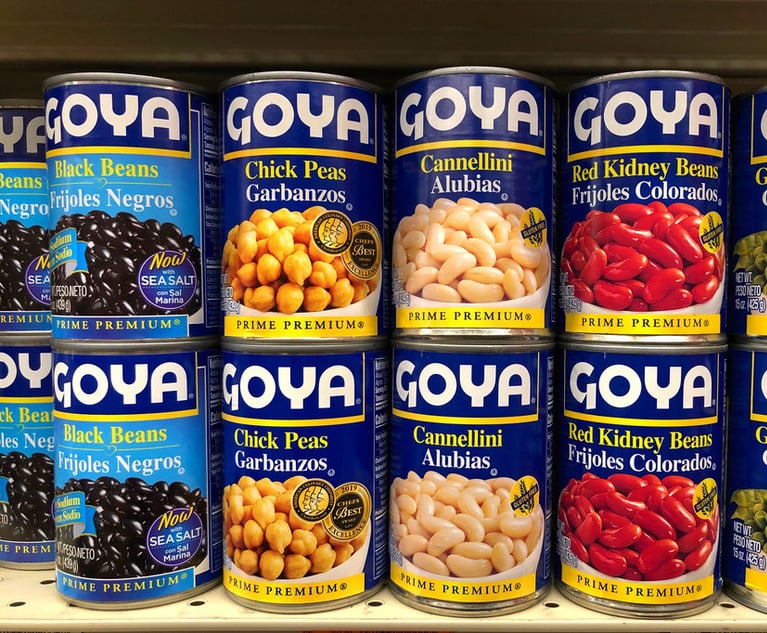IP: The Supreme Court levels its eye at agricultural GMOs
The centuries-old common law rule against unreasonable restraints on alienation of property discourages limitations on the free exchange or transfer of property as a brake on the efficient allocation of resources.
January 22, 2013 at 04:15 AM
6 minute read
The original version of this story was published on Law.com
The centuries-old common law rule against unreasonable restraints on alienation of property discourages limitations on the free exchange or transfer of property as a brake on the efficient allocation of resources. This principle underlies the common law rule against perpetuities, providing that interests must vest within 21 years of a life in being at the time of interest creation.
In the context of patent law, these principles are evident in the patent exhaustion doctrine. This doctrine provides that the first authorized sale of patented subject matter, such as a product, completely exhausts the patentee's rights to control that subject matter, such as by influencing a subsequent use or sale. Recently, these well-settled principles of the common law have run smack into modern technology in the ongoing patent infringement battles being waged by Monsanto Co. against farmers and grain elevator operators concerning genetically modified organisms (GMOs) in agriculture, such as Roundup Ready crops. One of these patent disputes, Bowman v. Monsanto Co., has now reached the Supreme Court, with oral arguments scheduled for Feb. 19. The bulk of amicus briefs filed in the matter are by non-profit and public interest groups favoring Bowman; the U.S. Solicitor General has filed the only amicus brief favoring the respondent.
Monsanto's GMO plants resist herbicide
The technology at issue in Bowman is herbicide-resistant crop plants. In Bowman, the crop is soybeans, but the technology has been successfully applied to various crop plants, including alfalfa, canola, corn, cotton and sugar beets. The herbicide involved is N-phosphonomethyl glycine, commonly known as glyphosate, which is a widely used organophosphorus broad-spectrum herbicide. Glyphosate was developed by Monsanto in the 1970s and has grown to play a significant role in the herbicide market. Glyphosate's growth is due, in part, to its function as an inhibitor of a biosynthetic pathway unique to plants. As a consequence, glyphosate was thought to be safe for use around animals. The herbicide would hardly be popular if it went beyond killing weeds to killing crop plants, however. To avoid such deleterious effects, crop plants were engineered by Monsanto to resist glyphosate. The herbicide is the active ingredient in Roundup herbicide, and resistant plants are Roundup Ready (RR) plants. Roundup Ready plants have been genetically engineered to express a mutant version of the gene targeted by glyphosate, and to express that mutant gene at an elevated level. Thus, the genetic engineering undertaken by Monsanto Co. was not straightforward or trivial, and the company seeks a return on its substantial research and development investment.
GMO plants self-replicate
Monsanto Co., as provider of the herbicide Roundup as well as the RR crop plants compatible with that herbicide, would appear to be well-positioned to profit from the need to control weeds in agriculture, but there is a problem. RR crop plants, like all living things, are capable of reproduction. If Monsanto sells its patented seeds to a farmer, the patent exhaustion doctrine would suggest that Monsanto's interests were completely exhausted upon the sale of seeds. A farmer planting the purchased seeds could obtain seeds for subsequent crops from the plants being grown rather than returning to Monsanto. Moreover, the farmer could sell seeds from his crops, thereby competing with Monsanto. Realizing the potential predicament, Monsanto avoided the potentially crippling application of the patent exhaustion doctrine by alienating seed by license rather than unconditional sale.
Mr. Bowman bought RR crop seed from Monsanto, grew it and sold the seeds of the grown plants to a grain elevator, a sale that was authorized by the license if the sold seeds were used as commodities and not planted to grow more plants. Bowman also bought seed from the grain elevator to grow second crops late in the growing season. Monsanto discovered the planting of grain elevator seed and sued.
In the district court, Monsanto prevailed on summary judgment. The district court held that Bowman infringed the Monsanto patents by his unauthorized planting of the grain elevator seed because the license-limited alienation of RR seeds by Monsanto did not exhaust its patent rights. The Federal Circuit, which hears all patent appeals, affirmed the district court's judgment.
Patent rights aren't (currently) exhausted by first sale of self-replicating technology
In the appellate proceeding, Bowman argued that the Monsanto license authorized the sale of seed to grain elevators and that authorized sale exhausted Monsanto's patent rights under the Supreme Court's analysis in Quanta Computer, Inc. v. LG Electronics, Inc. Bowman also argued that the purchased seeds substantially embodied each subsequent generation of seeds, like Russian nesting dolls, and that if this were not the case, the exhaustion doctrine was useless in this context.
Monsanto countered that Quanta was not controlling because Monsanto's sale of seeds was restricted, unlike the unrestricted sale at issue in Quanta. Thus, authorized sales of Monsanto's seeds were limited by the license and did not exhaust Monsanto's rights relating to unauthorized uses. Monsanto then argued that each generation of plants, or seeds, is a newly created infringing article. In affirming the district court judgment, the appellate court held that the authorized, but restricted, sale of RR seeds did not exhaust Monsanto's patent rights. Further, because the grain elevator seeds were not limited to planting as the only reasonable and intended use, the sold seeds could not be regarded as embodying future generations of seeds.
Undaunted, Bowman petitioned the Supreme Court for review. Some were surprised when, on Oct. 5, 2012, the court granted the petition. The questions to be addressed before the Supreme Court are whether the appellate court erred in not finding patent exhaustion upon the sale of RR soybean seeds and whether an exception to the patent exhaustion doctrine should be created for self-replicating technologies.
Many in the biotechnology and agricultural fields felt that Monsanto limited its alienation of RR seeds by license, thereby avoiding patent exhaustion, and the district and appellate courts confirmed that view. The Supreme Court's willingness to review, and the questions presented, have unsettled the industries. At this point, it is unclear what, if anything, the Supreme Court will do to the patent exhaustion doctrine, but the consequences could be enormous for industries reliant on self-replicating technologies. The Court's recent bold decisions in the field of biotechnology, such as Mayo Collab. Serv. v. Prometheus Labs., Inc., have done nothing to bank fears that a Bowman decision could dramatically alter the commercial prospects for these self-replicating technologies.
DISCLAIMER: The information contained in this article is for informational purposes only and is not legal advice or a substitute for obtaining legal advice from an attorney. Views expressed are those of the author and are not to be attributed to Marshall, Gerstein & Borun LLP or any of its former, present or future clients.
This content has been archived. It is available through our partners, LexisNexis® and Bloomberg Law.
To view this content, please continue to their sites.
Not a Lexis Subscriber?
Subscribe Now
Not a Bloomberg Law Subscriber?
Subscribe Now
NOT FOR REPRINT
© 2025 ALM Global, LLC, All Rights Reserved. Request academic re-use from www.copyright.com. All other uses, submit a request to [email protected]. For more information visit Asset & Logo Licensing.
You Might Like
View All
Best Practices for Adopting and Adapting to AI: Mitigating Risk in Light of Increasing Regulatory and Shareholder Scrutiny
7 minute read
FOMO Run Amok? Resolve of Firms Chasing AI Dreams Tested by Sky-High Costs


Trending Stories
Who Got The Work
Michael G. Bongiorno, Andrew Scott Dulberg and Elizabeth E. Driscoll from Wilmer Cutler Pickering Hale and Dorr have stepped in to represent Symbotic Inc., an A.I.-enabled technology platform that focuses on increasing supply chain efficiency, and other defendants in a pending shareholder derivative lawsuit. The case, filed Oct. 2 in Massachusetts District Court by the Brown Law Firm on behalf of Stephen Austen, accuses certain officers and directors of misleading investors in regard to Symbotic's potential for margin growth by failing to disclose that the company was not equipped to timely deploy its systems or manage expenses through project delays. The case, assigned to U.S. District Judge Nathaniel M. Gorton, is 1:24-cv-12522, Austen v. Cohen et al.
Who Got The Work
Edmund Polubinski and Marie Killmond of Davis Polk & Wardwell have entered appearances for data platform software development company MongoDB and other defendants in a pending shareholder derivative lawsuit. The action, filed Oct. 7 in New York Southern District Court by the Brown Law Firm, accuses the company's directors and/or officers of falsely expressing confidence in the company’s restructuring of its sales incentive plan and downplaying the severity of decreases in its upfront commitments. The case is 1:24-cv-07594, Roy v. Ittycheria et al.
Who Got The Work
Amy O. Bruchs and Kurt F. Ellison of Michael Best & Friedrich have entered appearances for Epic Systems Corp. in a pending employment discrimination lawsuit. The suit was filed Sept. 7 in Wisconsin Western District Court by Levine Eisberner LLC and Siri & Glimstad on behalf of a project manager who claims that he was wrongfully terminated after applying for a religious exemption to the defendant's COVID-19 vaccine mandate. The case, assigned to U.S. Magistrate Judge Anita Marie Boor, is 3:24-cv-00630, Secker, Nathan v. Epic Systems Corporation.
Who Got The Work
David X. Sullivan, Thomas J. Finn and Gregory A. Hall from McCarter & English have entered appearances for Sunrun Installation Services in a pending civil rights lawsuit. The complaint was filed Sept. 4 in Connecticut District Court by attorney Robert M. Berke on behalf of former employee George Edward Steins, who was arrested and charged with employing an unregistered home improvement salesperson. The complaint alleges that had Sunrun informed the Connecticut Department of Consumer Protection that the plaintiff's employment had ended in 2017 and that he no longer held Sunrun's home improvement contractor license, he would not have been hit with charges, which were dismissed in May 2024. The case, assigned to U.S. District Judge Jeffrey A. Meyer, is 3:24-cv-01423, Steins v. Sunrun, Inc. et al.
Who Got The Work
Greenberg Traurig shareholder Joshua L. Raskin has entered an appearance for boohoo.com UK Ltd. in a pending patent infringement lawsuit. The suit, filed Sept. 3 in Texas Eastern District Court by Rozier Hardt McDonough on behalf of Alto Dynamics, asserts five patents related to an online shopping platform. The case, assigned to U.S. District Judge Rodney Gilstrap, is 2:24-cv-00719, Alto Dynamics, LLC v. boohoo.com UK Limited.
Featured Firms
Law Offices of Gary Martin Hays & Associates, P.C.
(470) 294-1674
Law Offices of Mark E. Salomone
(857) 444-6468
Smith & Hassler
(713) 739-1250






